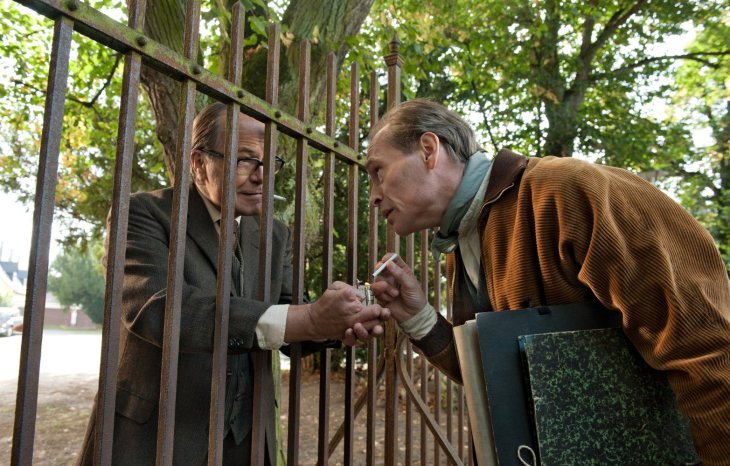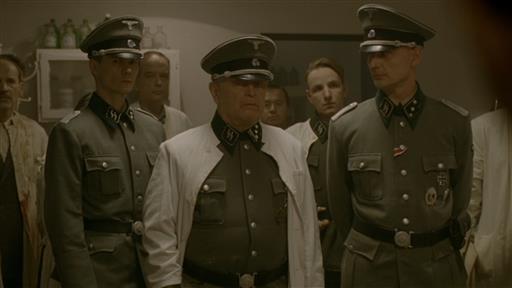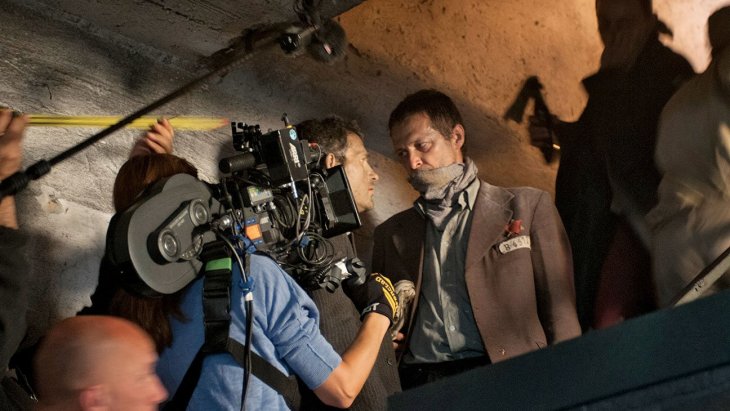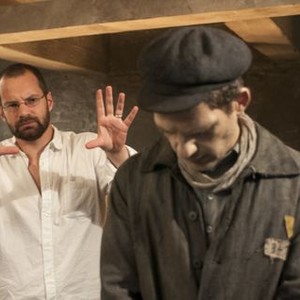Im Labyrinth des Schweigens (2014). Dir. Giulio Ricciarelli

















Major Parker (Tim Williams). En alemán en la película (el Mayor Parker, norteamericano, habla en alemán con Johann Radmann): “You were all Nazis. In the Eastern sector, now you are all communists. Jesus, you Germans! If little green men from Mars landed tomorrow, you would all become green“.
¡Por fin una película que muestra la culpabilidad del alemán común en el Holocausto! El Holocausto no se produjo gracias a 4 psicópatas nazis, sino gracias a millones de hombres (el 90% de los alemanes desde los años 1940-41) que abrazaron el nazismo y que colaboraron felices en la humillación, exclusión, masacre y exterminio de millones de hombres, mujeres y niños inocentes. Dos libros que muestran brillantemente la colaboración de la inmensa mayoría de alemanes en la gigantesca máquina exterminadora nazi son Rethinking the Holocaust de Yehuda Bauer (una obra maestra) y Hitler’s Willing Executioners: Ordinary Germans and the Holocaust de Daniel Goldhagen.
Im Labyrinth des Schweigens muestra el rápido olvido en Alemania de las atrocidades cometidas por los alemanes tan solo 10 años después de la liberación de los campos de concentración y exterminio nazis, y la impunidad de la que gozaron los millones de alemanes que formaron parte de la gran maquinaria que produjo el Holocausto. Antes del famoso juicio de Eichmann en 1961, muy pocos alemanes habían oído hablar de Auschwitz.
Im Labyrinth des Schweigens se centra en el período anterior a los juicios que tuvieron lugar en Frankfurt del 20 de diciembre de 1963 al 19 de agosto de 1965 (der Auschwitz-Prozess) contra unos poquísimos SS que operaron en Auschwitz. Los juicios fueron ridículos y un escupo contra las 1.100.000 víctimas masacradas y gaseadas en Auschwitz. De los 7.000 SS que operaron en Auschwitz durante la guerra, solamente 22 SS fueron enjuiciados en los juicios de Frankfurt. No obstante, el intento por una pizca minúscula de justicia fue importante. De los 22 SS, solamente 6 recibieron cadena perpetua, muchos unas penas ridículas de 3 a 10 años, y 5 fueron puestos en libertad. Im Labyrinth des Schweigens muestra la extrema dificultad por juzgar a los responsables, debido al silencio de los alemanes y a su intento por esconder la verdad y la responsabilidad. Personalmente pienso que la única manera que tienen hoy los alemanes (y los austríacos) de limpiarse la sangre que sus abuelos y bisabuelos derramaron es ser profundamente antinazi. Pero ¿cuántos alemanes y austríacos hay hoy que sean profundamente antinazis? Hoy Alemania se siente moderna y ecológica, pero hace tan solo 78 años que gaseaba a niños. Y el mundo lo ha olvidado.
Im Labyrinth des Schweigens obtuvo varios premios (aunque ninguno extremadamente importante) y fue la película que Alemania presentó para la categoría ‘Best Foreign Language Film’ (Oscars, 2016), aunque no llegó a ser nominada.
“Schweigen” es “silencio” en alemán. La traducción correcta del título sería “En el laberinto del silencio”, pero tanto en inglés como en español, el título ha sido mal traducido (Labyrinth of Lies / La conspiración del silencio). Nunca he entendido esta pasión por cambiar los títulos originales de las películas.
Lo mejor: que la culpabilidad en el Holocausto del cerdo alemán común salga finalmente a flote.
Lo peor: que aunque la película muestre a Fritz Bauer (el juez que hizo posible los juicios de Frankfurt), el personaje de Johann Radmann (interpretado brillantemente por Alexander Fehling) sea ficticio.
Im Labyrinth des Schweigens / Trailer
 Antonia Tejeda Barros, Madrid, 29 de noviembre de 2016
Antonia Tejeda Barros, Madrid, 29 de noviembre de 2016
Major Parker (Tim Williams). Originally in German in the movie (the American Major speaks German to Johann Radmann): “You were all Nazis. In the Eastern sector, now you are all communists. Jesus, you Germans! If little green men from Mars landed tomorrow, you would all become green”.
Finally a movie that shows the culpability of the common German people in the Holocaust! The Holocaust didn’t happen just because of 4 Nazi psychos, but thanks to millions of ordinary men (90% of the Germans from 1940-41) who supported the Nazi ideology and happily collaborated in the massacres of millions of innocent men, women and children. By the way, two books that brilliantly demonstrate the collaboration of the vast and overwhelming majority of Germans in the gigantic Nazi killing machine are Rethinking the Holocaust by Yehuda Bauer (a masterpiece) and Hitler’s Willing Executioners: Ordinary Germans and the Holocaust by Daniel Goldhagen.
Im Labyrinth des Schweigens shows the fast oblivion in Germany of the atrocities committed by the Germans just 10 years after the liberation of the Nazi concentration and extermination camps, and the impunity millions of murderers enjoyed, people who humilliated, excluded, tortured, massacred and gassed millions of Jewish (and non-Jewish) men, women, and children in the 1940s. Only very few Germans had heard about Auschwitz before the famous Eichmann trial in 1961.
Im Labyrinth des Schweigens focuses on the the period prior to the trials that took place in Frankfurt between December 20, 1963 and August, 1965 (der Auschwitz-Prozess) against very few fucking SS members who operated in Auschwitz. The trials were ridiculous and a spit on the 1,100,000 victims who were massacred and gassed in Auschwitz. From the 7,000 SS who operated in Auschwitz during the war, only 22 SS were judged at the Frankfurt Trials. Nevertheless, the attempt for a pinch of justice was important. From the 22 SS only 6 got life imprisonment, many got ridiculous sentences ranging from 3 to 10 years, and 5 were simply released. Im Labyrinth des Schweigens shows the extreme difficulty of judging the murderers because of the silence the Germans kept and their attempt to hide the truth and their own responsibility. Personally I believe that the only way Germans (and Austrians) have today to clean the blood their grandparents and great-grandparents spilled is to be deeply anti-Nazi. But how many Germans and Austrians are there today who are deeply anti-Nazi? Today Germany dresses herself as a modern and eco-friendly country, but, please, let’s not forget that only 78 years ago Germany was burning million of children in ovens.
Im Labyrinth des Schweigens got many prizes (although none were extremely important) and it was the film that Germany presented for the category ‘Best Foreign Language Film’ (Oscars, 2016), although it was not nominated.
“Schweigen” is “silence” in German. The correct translation of the title would be: “In the Labyrinth of Silence”. In English the title has been poorly translated as Labyrinth of Lies. I never understood this annoying passion for changing the original titles of the films.
The best: the fact that the culpability of the German common pig in the Holocaust finally arouses.
The worst: that even when the film shows Fritz Bauer (the judge who made the Frankfurt Trials possible), the character of Johann Radmann (brilliantly performed by Alexander Fehling) is fictitious.
Im Labyrinth des Schweigens / Trailer
 Antonia Tejeda Barros, Madrid, November 29, 2016
Antonia Tejeda Barros, Madrid, November 29, 2016
































 Antonia Tejeda Barros, Madrid, 31 de agosto de 201 6
Antonia Tejeda Barros, Madrid, 31 de agosto de 201 6